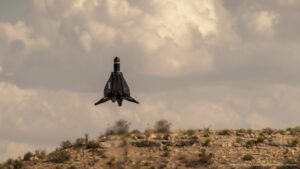The Army has submitted a $2.2 billion unfunded priorities list for fiscal year 2025 which includes requests for several counter-drone efforts and dollars to support work with Anduril’s Roadrunner-Munition autonomous air vehicle, according to a copy of the document obtained by Defense Daily.
At the top of the list, submitted to Congress for consideration following the FY ‘25 budget rollout, the Army is specifically seeking $350.3 million for projects related to dealing with small UAS threats.

While the list includes few program specifics, with the document designated as “controlled unclassified information,” the C-sUAS request is split between $184.8 million for missiles procurement and $165.5 million for “other” procurement for “force protection.”
Lt. Gen Sean Gainey, who previously led the Joint Counter-Small UAS Office and now heads Army Space and Missile Defense Command, said last October the Army’s aim is provide C-sUAS assets down to the platoon level, to include RTX’s [RTX] Coyote interceptors (Defense Daily, Oct. 11 2023).
The Army said in February it recently awarded RTX a $75 million contract for production of 600 Coyote 2C interceptors (Defense Daily, Feb. 9).
The service’s unfunded priorities list also requests $4.5 million for research and development work with Anduril’s Roadrunner-M, which the company first detailed last fall.
Anduril has said it began self-funded work two year ago on the jet-powered, highly maneuverable, and recoverable Roadrunner AAV, which has vertical take-off-and-landing capabilities, with the company founder Palmer Luckey noting the Roadrunner-M version is able to destroy full-size aircraft (Defense Daily, Dec. 1).
Luckey said at the time that Anduril has an unnamed U.S. customer for Roadrunner-M, adding that the capability has been “operationally assessed” and will begin low-rate initial production shortly for the customer with the expectation to scale to thousands of units.
The Army’s unfunded priorities list also includes $10 million for research and development to work on a “Family of Counter-sUAS System” effort.
For its own small drone efforts, the Army is seeking $10 million for its company-level small UAS, specifically the Short Range Reconnaissance (SRR) effort, $26.5 million for further SRR modernization-related work and $25 million for commercial off-the-shield sUAS solutions for Infantry Brigade Combat Teams.
Several weapons procurement-related items are also on the Army’s list, to include: $138.6 million for PAC-3 MSE interceptors and $98 million for Precision Strike Missiles, both built by Lockheed Martin [LMT], $91 million for Stinger missile upgrades and $10 million for the Lethal Unmanned System (LUS)/Low Altitude Stalk & Strike Ordinance (LASSO).
The Army Program Executive Officer-Soldier has previously said the new LASSO capability is intended to be a “man-portable, tube launched, lethal payload munition, unmanned aerial system” and the service is utilizing an urgent capability acquisition pathway to rapidly deliver it to Infantry Brigade Combat Teams (Defense Daily, July 7 2023).
The list also includes $44.1 million for the GM Defense [GM]-built Infantry Squad Vehicle and $33.2 million for Sig Sauer-produced Next Generation Squad Weapon ammunition.
There are two classified research and development efforts included on the Army’s list, “Iron Quest” and “Spectre,” with the Army seeking $12.2 million and $50 million, respectively, and $125.2 million for development work related to the service’s Human-Machine Integration (HMI) effort.
Gen. James Rainey, head of Army Futures Command, said in December the Army’s aim is to have to have full prototype HMI platoons in place by early 2025 for further experimentation (Defense Daily, Dec. 13).